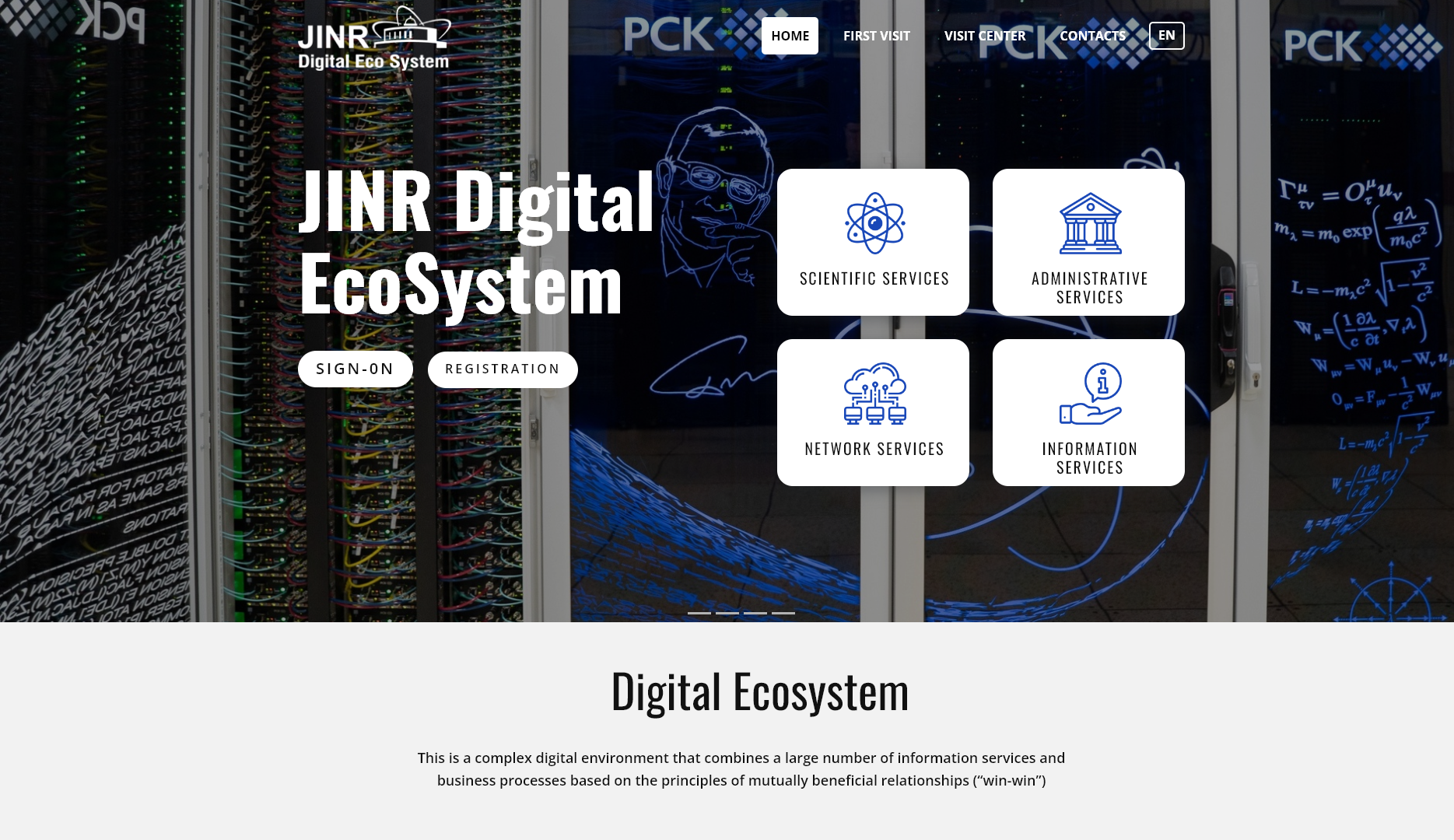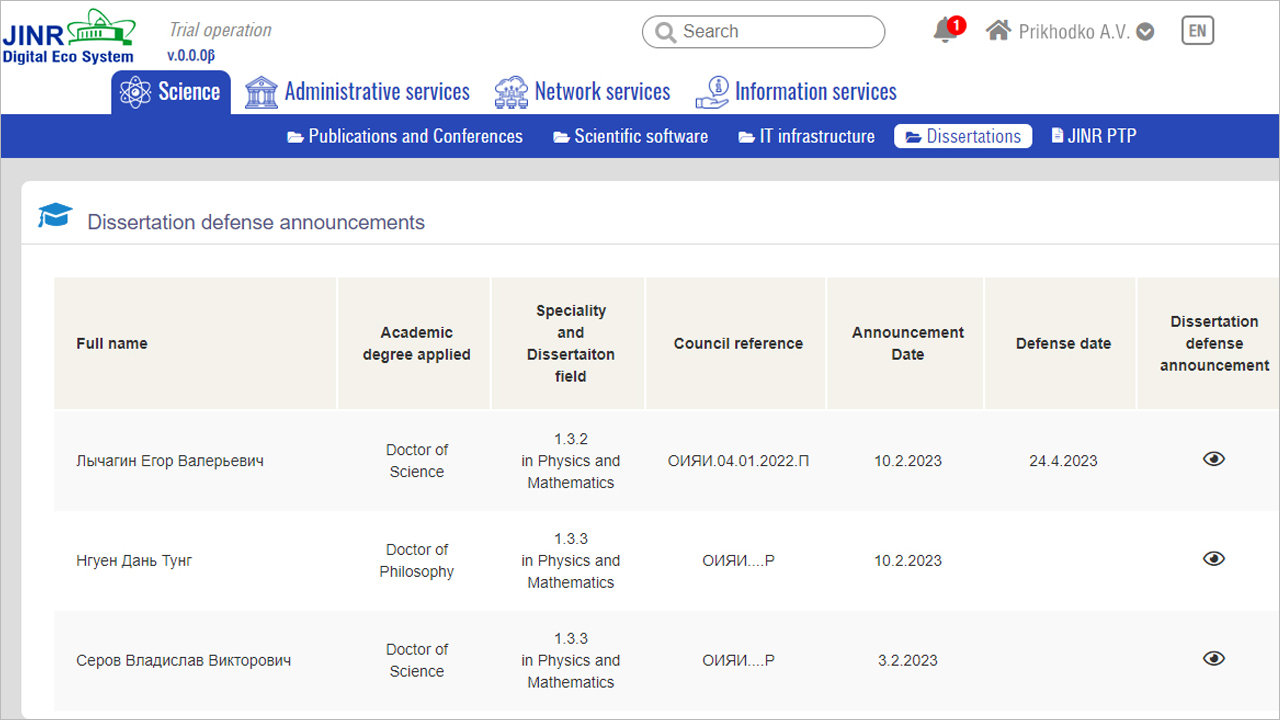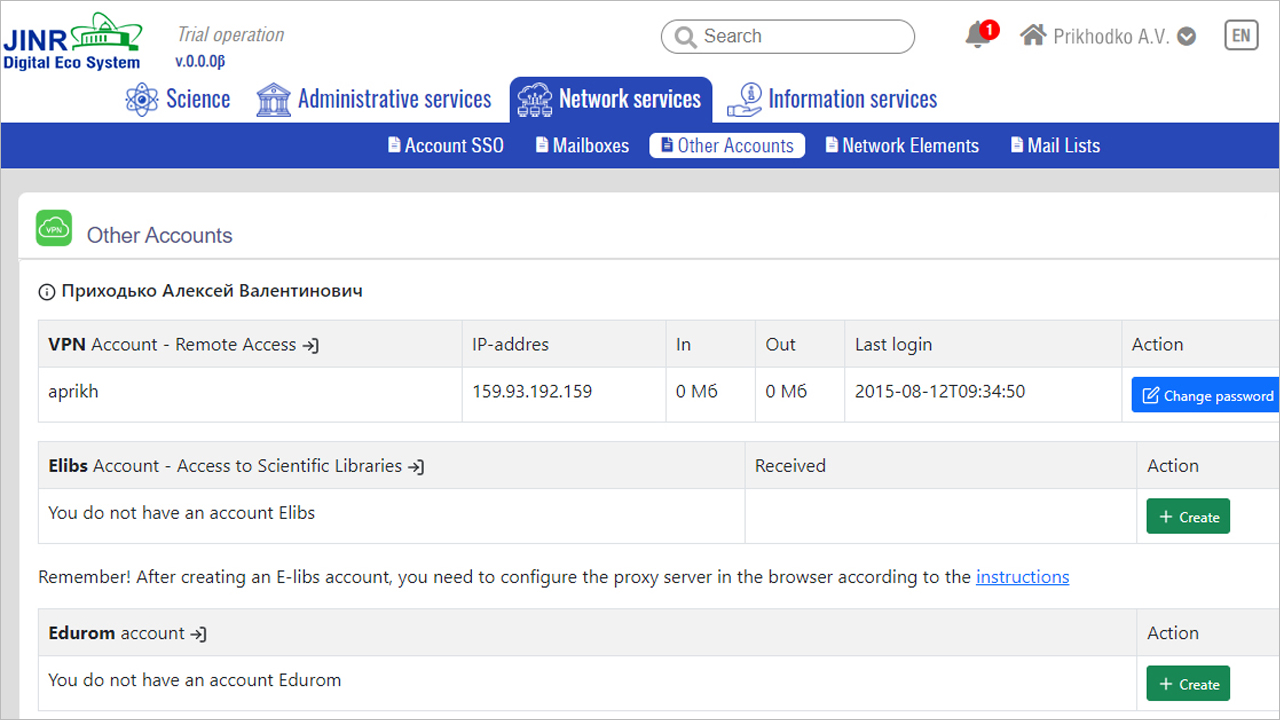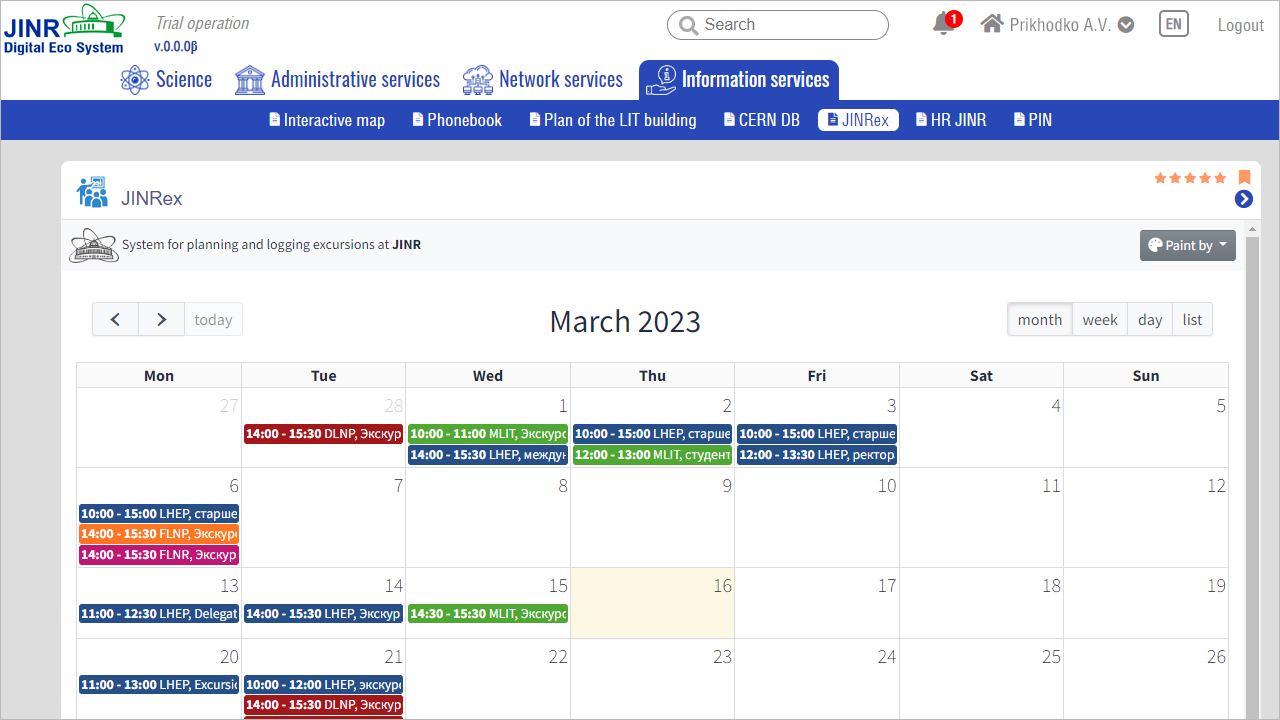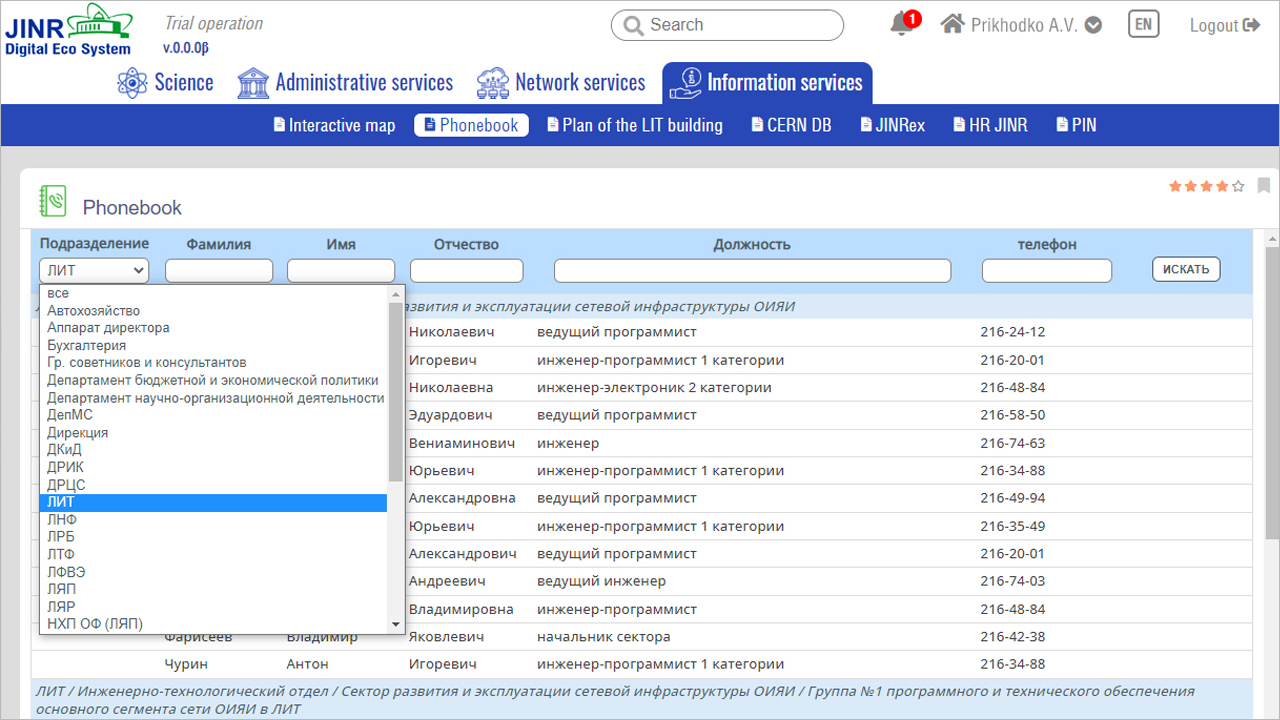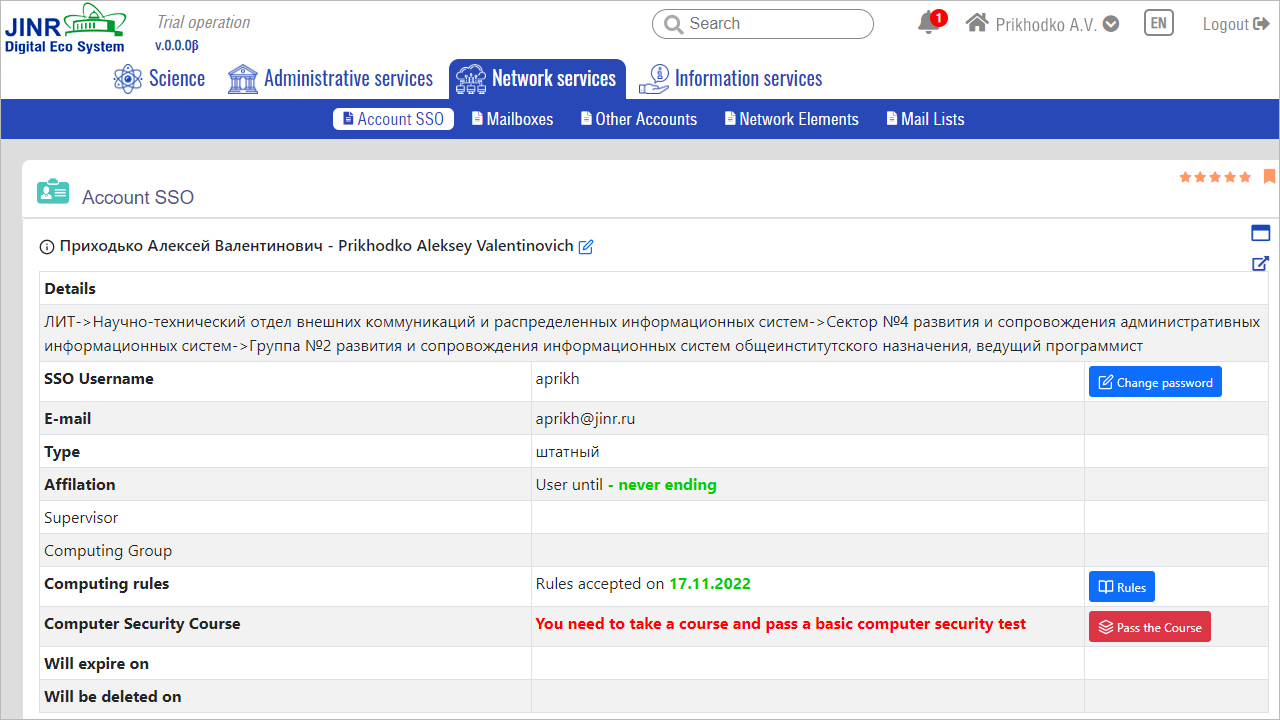JINR Digital Ecosystem launched in test mode
News, 30 March 2023
This week, the JINR Digital Ecosystem, a platform that provides access to the network of JINR information services, has been put into test operation. This includes both scientific and administrative services, from resources for users of basic facilities to registration of a personal computer in the JINR network or changing the mailbox password, ordering certificates and statements online. The log-in is possible from jinr.ru (section “Digital JINR”). Scientific Leader of the Meshcheryakov Laboratory of Information Technologies JINR Vladimir Korenkov spoke about the creation and future major development of the system and how it can save working time of employees. He also explained the reason the Institute needs a digital twin.
– Vladimir Vasilievich, please tell us why the implementation of this system is important for the Institute?
– The main prerequisite for the creation of the JINR Digital Ecosystem is that the Institute should gradually come to paperless document management. Walking around the offices and getting different kinds of stamps takes a lot of time and efforts. Second, a lot of information is duplicated. The same lists can be created in different departments of the Institute over and over again. Third, there are a number of information systems in JINR now that are not interconnected and which lack a single architecture, concept.
Thus, an idea emerged to connect systems running on different platforms so that they form a single environment. At the same time, notifications from different services should be collected in one place, so that when a user logs in, they can immediately see all their tasks and respond.
 MLIT JINR Scientific Leader Vladimir Korenkov
MLIT JINR Scientific Leader Vladimir Korenkov
– Who will be able to use the system?
– Some of the services are available to everyone. JINR employees and associated personnel can use the full capabilities of the system. Each staff member receives a Single Sign-On (SSO) account. This account allows users to log into the JINR Digital Ecosystem. Ideally, once a user has registered, they should be able to get any information without going to the offices. There is still much to be done in order to implement this, but the first steps have been taken. We have set ourselves the goal of gradually solving all these tasks.
Of course, not all the data will be widely available. Different access levels will be provided. There are personal data, as well as HR, technological information, which will be available only to those who have the right to access it.
We tried to make the interface of the system intuitive so that users do not even have to read any instructions. The set of services is very easily configured for a specific user. As a result, only those services that are needed will be displayed on the start screen of the system.
By putting the Digital Ecosystem into trial operation, we must, on the one hand, popularise its use among employees, on the other hand, accustom them to a certain corporate culture. Information security is critically important here. Therefore, every staff member and every user of the system will have to take a training course and pass a test on the basics of cybersecurity.
– Does the system provide feedback from users?
– Yes, it does. It has already been implemented and is actively used. Feedback is especially important to us. By September, it is planned to accumulate user reviews in order to prioritise the implementation and development of services. The results of the trial operation will be presented at the next meeting of the JINR Scientific Council.
– What has already been done by the time of the test launch?
– We have worked out the architecture of the Ecosystem by bringing those systems that have already worked to a universal standard, starting from network services. Previously, it was necessary to go to the network service office on every occasion. Now the user will be able to change passwords, create a new VPN, subscribe to newsletters, and register their computer online. In some services, the user receives a response to the request after moderation.
Now each JINR employee has several accounts in the systems in which he works. The Digital Ecosystem is a single window into them. Everything is collected in one place and available by one log-in: personnel, financial information, order for various administrative certificates. And this applies to general as well as scientific, administrative services. In the foreseeable future, this will significantly reduce the number of approvals and paperwork.
The system includes many different sections. Many are connected with the electronic document management system, with procurement, documents, and approval. But not only that. There are dissertation councils, guided tours support system, publication activity, work of collaborations, software, and programme libraries.
You will also find an interactive map of JINR sites in the Digital Ecosystem: buildings, offices, buses, catering, etc. In the future, with the help of the Ecosystem, it will be possible to find out the location of other employees, in which building they work and where this building is located. This has already been implemented at MLIT, VBLHEP is next. The are plans to digitise each laboratory, up to the point that it is possible to track the age of equipment employees use in their offices.
With the help of digital services, it will be possible to solve urgent problems. For example, during earthworks at the technical sites of the Institute, communications, i.e. optical cables, pipes etc. can be damaged sometimes. The reason is that often many technological systems are intertwined in one place. By using the Digital Ecosystem before carrying out such works, it is possible to check the location of the engineering infrastructure, and not just on paper, but in the form of a 3D scheme.
– And if a new core network was created, will it be immediately displayed in the system? How fast and often will it be updated?
– We still have a lot of work to do with this. The system is only “alive” when it is updated, when new content is constantly being added to it. If an employee has changed his office or department, he needs to promptly reflect this in the system. And this is also part of the new corporate culture that we all need to learn.
– Are there plans to embed something like a navigator into the interactive map in the future, which would help to build a route at our technical sites?
– It is almost done. The task has been set and the first results will be obtained within a month. The information system changes every day. The map will include bus routes, parking lots, and catering.
– What are the plans for the development of the system?
We are creating a management system for our computing complex, the engineering infrastructure of the Institute. Of course, we would like to do a lot to automate the activities of scientific collaborations. This applies to software, publications, and the teamwork mode of users. For example, in order to launch an accelerator, all collaboration information must be available to all the experiment groups. But now different groups of the same collaboration often do not have enough information about each other.
In addition, we see the potential for the Digital Ecosystem to incorporate analytics in it as well. It would cover our entire institute life, i.e. publications, scientific results, business trips, the average age of staff, and so on. We will observe how different parameters change over time. Thus, we will be able to make predictions as to how we can better develop, how we can carry out personnel, financial, and technical policies. This will allow us to take the best decisions and make the Institute’s work more and more effective.
– How would this differ from the monitoring.jinr.ru system, which also has indicators for staff age and publications?
– These indicators are entered manually, but our aim is to make most indicators part of the system and be determined from the services automatically.
Our second dream is to create a digital twin of JINR, a virtual model of the organization’s work. That is quite an ambitious task, not a single scientific organization has done it before JINR. There is a concept of a digital twin of a technical system. It can be used, for example, in the aircraft design. The twin allows loads and other parameters to be analysed, and only after a complete analysis is the real aircraft made. And such a twin is needed not only at the design stage. A digital twin will support the entire lifecycle of the system. If we see problems in real time, with its help we can analyse them, predict, and make changes and optimisations.
– Will it be possible to combine it with an analytical system, with live data?
– The digital twin can only be implemented once the Ecosystem is up and running and automated analytics have been incorporated into it. The idea behind the twin is that it should fully match the real Institute at each moment of time. Only then will it be possible to solve serious management tasks with its help.
We are at the beginning of our journey. Now there are several dozen services in the system, and this number will grow. Therefore, our key task here is to create a single service integration bus so that systems can be connected and integrated with each other. It is necessary that information from different subsystems is transmitted across all the services. This is important for global tasks as well as more immediate ones. For example, to allow users to receive automatically generated lists on request. Now in any laboratory HR managers, accountants, secretaries have a lot of lists. These are the same documents, each time typed anew in manual mode. In this case, an error may occur.
– Is there an opportunity to develop the JINR Ecosystem at institutions of the Member States?
– Yes, there is already an agreement on the first integration of the JINR Digital Ecosystem with Dubna University. This will be the first experience of transferring part of the services to a new platform, as well as integrating third-party subsystems into it.
